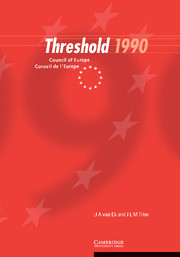Book contents
- Frontmatter
- Contents
- Preface
- Introduction
- 1 The objective: levels of specificity
- 2 The objective: general characterisation
- 3 The objective: extended characterisation
- 4 The objective: components of the specification
- 5 Language functions
- 6 General notions
- 7 Specific notions
- 8 Verbal exchange patterns
- 9 Dealing with texts: reading and listening
- 10 Writing
- 11 Sociocultural competence
- 12 Compensation strategies
- 13 Learning to learn
- 14 Degree of skill
- APPENDICES
Preface
Published online by Cambridge University Press: 26 February 2010
- Frontmatter
- Contents
- Preface
- Introduction
- 1 The objective: levels of specificity
- 2 The objective: general characterisation
- 3 The objective: extended characterisation
- 4 The objective: components of the specification
- 5 Language functions
- 6 General notions
- 7 Specific notions
- 8 Verbal exchange patterns
- 9 Dealing with texts: reading and listening
- 10 Writing
- 11 Sociocultural competence
- 12 Compensation strategies
- 13 Learning to learn
- 14 Degree of skill
- APPENDICES
Summary
Threshold is the latest, thoroughly revised, extended, corrected and reset version of The Threshold Level by Dr. J. A. van Ek, first published by the Council of Europe in 1975 as part of a project to investigate the feasibility of a unit/credit system for adult language learning in Europe. The Project Group set out to develop conceptual and planning instruments to assist teachers and course planners to analyse the needs of the learners towards whom they had responsibilities and to set, consciously and explicitly, appropriate learning objectives.
Learning objectives will, in principle, be as diverse as the learners and the lives they lead. However, large-scale educational systems have to base their provision on learners' common needs. By far the largest single group of language learners everywhere consists of people who want to prepare themselves to communicate socially with people from other countries, exchanging information and opinions on everyday matters in a relatively straightforward way, and to conduct the necessary business of everyday living when abroad with a reasonable degree of independence. The Threshold Level was the first attempt to set out in systematic detail just what such an objective implies in terms of the situations the learners might have to deal with and what they should be able to do by means of language in those situations – what feelings and ideas they would need to express, or ask about, or argue about, and in general conduct personal relations in daily life.
- Type
- Chapter
- Information
- Threshold 1990 , pp. 1 - 3Publisher: Cambridge University PressPrint publication year: 1998

